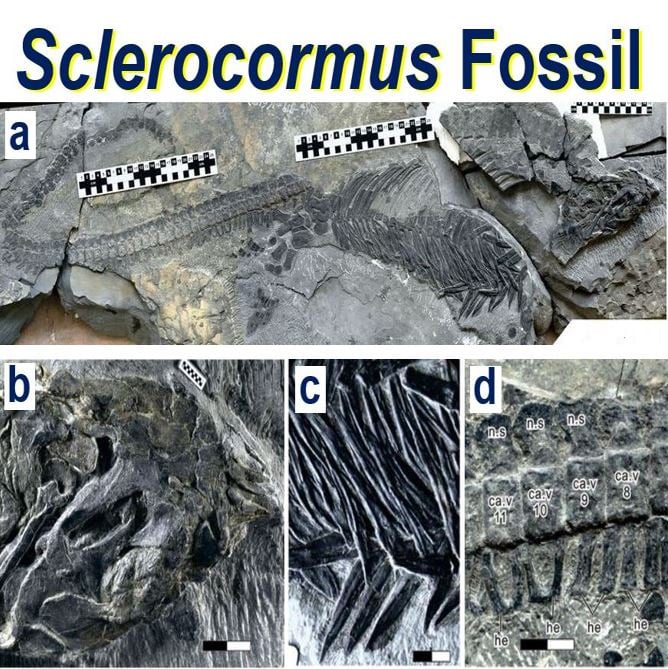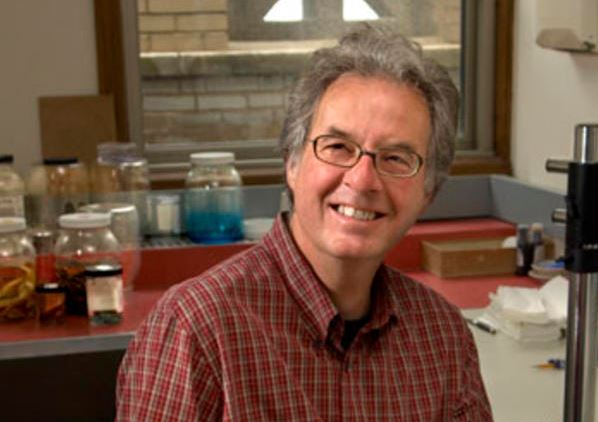There was a mass extinction 250 million years ago which wiped out 96% of all marine life. Scientists have always believed that the early marine reptiles that emerged afterwards evolved slowly – that is, until a strange new fossil suggested otherwise.
The mass extinction of 250 million years ago – The Permian-Triassic Extinction or End Permian Extinction – made the more recent one that pushed the dinosaurs to extinction look like child’s play. Apart from the devastation to marine life, it killed off 57% of all families on land and sea, 83% of all genera and from 90% to 96% of all species. It was Earth’s largest extinction.
Life was in a tail spin
Two hundred and fifty million years ago sea levels were rising, there were widespread volcanic eruptions, and climate change was altering the habitat of all life forms – basically, life on Earth was in a tail spin.
 (a) Sclerocormus parviceps, whole specimen. (b) Skull. (c) Close-up of gastral basket. (d) Close-up of U-shaped haemal arches. (Image: Scientific Reports)
(a) Sclerocormus parviceps, whole specimen. (b) Skull. (c) Close-up of gastral basket. (d) Close-up of U-shaped haemal arches. (Image: Scientific Reports)
This latest study, carried out by scientists from the USA, UK, Scotland and China, has been published in the journal Scientific Reports (citation below). In the journal, the authors describe a new marine reptile Sclerocormus parviceps, an ichthyosauriform that is challenging much about what we think we know what ichthyosaurs were like.
Ichthyosaurs were a huge group of marine reptiles that existed about the same time as the earliest dinosaurs. They looked a little like modern dolphins – with long beak-like snouts, streamlined bodies, and powerful tail fins.
New find different from others
However, this new species is something of a black sheep. Instead of a tail with triangular flukes it had a long tail like a whip without large fins at the end. It also had a short snout, and was toothless – most ichthyosaurs had conical teeth for grabbing prey.
Sclerocormus parviceps fed by creating pressure in its short snout to suck up food like a syringe. Put simply – it was considerably different from its cousins, which tells us something important about evolution.
 This latest fossil find has changed what we think we know about evolution, Olivier Rieppel said. (Image: fieldmuseum.org)
This latest fossil find has changed what we think we know about evolution, Olivier Rieppel said. (Image: fieldmuseum.org)
Co-author, Olivier Rieppel, Rowe Family Curator of Evolutionary Biology at The Field Museum in Chicago, USA, said:
“Sclerocormus tells us that ichthyosauriforms evolved and diversified rapidly at the end of the Lower Triassic period. We don’t have many marine reptile fossils from this period, so this specimen is important because it suggests that there’s diversity that hasn’t been uncovered yet.”
The way Sclerocormus evolved into such a different form so rapidly tells us a lot about how evolution actually works, the authors said.
Ichthyosauriforms evolved rapidly
Dr. Rieppel said:
”Darwin’s model of evolution consists of small, gradual changes over a long period of time, and that’s not quite what we’re seeing here. These ichthyosauriforms seem to have evolved very quickly, in short bursts of lots of change, in leaps and bounds.”
Creatures like Sclerocomus that existed immediately following the mass extinction also provide us with insight into how life responds to huge environmental pressures.
Dr. Rieppel explained:
“We’re in a mass extinction right now, not one caused by volcanoes or meteorites, but by humans. So while the extinction 250 million years ago won’t tell us how to solve what’s going on today, it does bear on the evolutionary theory at work. How do we understand the recovery and rebuilding of a food chain, of an ecosystem? How does that get fixed, and what comes first?”
In an Abstract that describes the main article in the journal, the authors wrote:
“Contrary to the fast radiation of most metazoans after the end-Permian mass extinction, it is believed that early marine reptiles evolved slowly during the same time interval.”
“However, emerging discoveries of Early Triassic marine reptiles are questioning this traditional view. Here we present an aberrant basal ichthyosauriform with a hitherto unknown body design that suggests a fast radiation of early marine reptiles.”
Citation: “A large aberrant stem ichthyosauriform indicating early rise and demise of ichthyosauromorphs in the wake of the end-Permian extinction,” Nicholas C. Fraser, Cheng Ji, Neil P. Kelley, Da-Yong Jiang, Ryosuke Motani, Jian-Dong Huang, Andrea Tintori, Yuan-Chao Hu, Olivier Rieppel, Wan-Lu Fu & Rong Zhang. Scientific Reports 6. Article Number: 26232. 23rd May 2016. DOI: 10.1038/srep26232.
Video – Ophthalmosaurus in the ocean
In this video, part of a BBC Earth documentary, you can see an animation of Ophthalmosaurus – a type of ichthyosaur – swimming in the ocean and giving birth. The video is not related to the study. Sclerocormus parviceps did not have a long snout, like the one in this footage, and its tail was quite different too.

